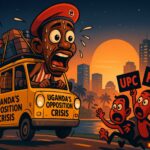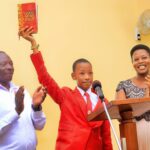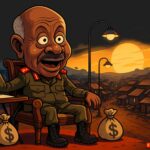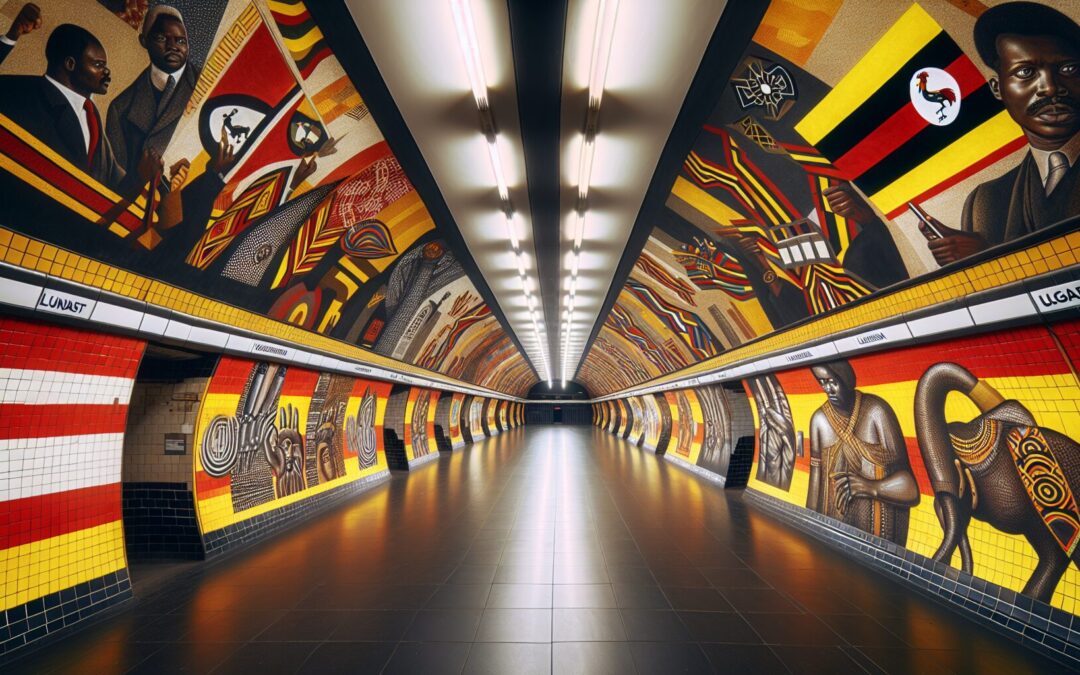Buganda Dominance vs. Northern Marginalisation: The Roots of Uganda’s Ethnic Divide
In the shadow of the British Empire, Uganda’s path to independence in 1962 was far more complex than a straightforward clash between coloniser and colonised. It was a labyrinth of ethnic alliances, regional power struggles, and the unintended repercussions of colonial policies that entrenched divisions rather than unity. At the core of this turbulent narrative lies the Acholi people of northern Uganda, whose political mobilisation under leaders like Milton Obote exposes the profound irony of British rule: institutions designed to pacify and control local populations instead became catalysts for ethnonationalist movements. This article delves into the paradox of colonial modernity —a system that sought to govern through indigenous structures but inadvertently sharpened ethnic identities, sowing the seeds of discord that would haunt post-independence Uganda.
The British policy of indirect rule , which co-opted traditional Acholi governance systems into the colonial Native Administration, initially minimised overt conflict. By governing ethnic groups as separate administrative units, the British avoided immediate unrest but deepened regional fissures. The Acholi, like other northern groups, were drawn into a system that offered limited political agency while reinforcing their status as marginalised “outsiders” compared to the culturally dominant Baganda of the south. This arrangement created a dual reality: Acholi leaders collaborated with colonial authorities to retain influence, yet their communities increasingly viewed the system as a tool of subjugation.
As decolonisation loomed, the tensions simmering beneath the surface erupted into overt ethnonationalism. The British, having institutionalised ethnic divisions, found themselves ensnared by their own strategies. The Acholi, once collaborators, began articulating anti-colonial grievances through a lens of regional identity. Figures like Obote—a Lango politician who became the voice of northern Uganda—leveraged these frustrations, framing independence not just as liberation from British rule but as a rebuke to southern hegemony. The colonial legacy of segregated governance thus birthed a political landscape where ethnic loyalty eclipsed national unity, setting the stage for Uganda’s fraught post-colonial journey.
- Indirect Rule and the Foundations of Ethnic Division
British colonial administrators in Uganda employed indirect rule as a pragmatic strategy to govern vast territories with limited manpower. By co-opting traditional Acholi governance structures—such as clan leadership and local councils—into the colonial Native Administration, the British sought to minimise resistance while maintaining control. This system allowed Acholi leaders to retain nominal authority over local affairs, acting as intermediaries between their communities and colonial overlords. Superficially, this approach reduced immediate conflict by preserving elements of pre-colonial governance. However, it inadvertently institutionalised ethnic divisions, embedding regional identities into the political fabric of the Protectorate.The British formalised regional administrations along ethnic lines, treating districts like Acholi, Buganda, and Lango as distinct administrative units. Resources, political offices, and infrastructure were allocated within these boundaries, fostering competition rather than collaboration between groups. For instance, the Acholi were confined to their northern districts, while the Baganda of the south enjoyed disproportionate influence due to their perceived “civilised” status and closer alignment with British interests. This segregation stifled cross-cultural dialogue and entrenched the idea that political power was inherently tied to ethnic identity.Crucially, indirect rule distorted traditional Acholi governance. Pre-colonial systems had emphasised fluid leadership and communal decision-making, but colonial administrators rigidified these structures to serve imperial ambitions. Local leaders were transformed into bureaucrats enforcing British policies, such as tax collection and labour recruitment. While this granted some Acholi elites a semblance of power, it also positioned them as collaborators in their communities’ subjugation. Over time, this duality—collaboration without autonomy—bred resentment, as ordinary Acholi increasingly viewed both the Native Administration and its local agents as instruments of foreign domination.The British further entrenched divisions through electoral engineering. By the 1950s, legislative council (LC) elections were structured to reflect ethnic demographics, ensuring that representatives from Acholi and other northern districts competed within narrowly defined constituencies. The 1958 elections exemplified this: in Acholi, the Uganda National Congress (UNC) candidate won by a mere 320 votes against the Democratic Party (DP), highlighting how tightly ethnic loyalties dictated political outcomes. Such divisions were not accidental but a deliberate byproduct of colonial governance, as the British prioritised control over cohesion.The legacy of these policies outlived colonial rule. By formalising ethnic boundaries, indirect rule laid the groundwork for post-independence ethnonationalism. Leaders like Milton Obote would later exploit northern grievances, framing independence as a struggle not just against colonialism but against southern (particularly Baganda) hegemony. The British, having weaponised ethnic identity to govern, ultimately became victims of their own strategy: the very institutions designed to pacify Uganda instead fragmented it, leaving a nation fractured along lines the colonisers had drawn.
In essence, indirect rule was a double-edged sword. While it stabilised the Protectorate in the short term, its emphasis on ethnic differentiation cemented divisions that would define Uganda’s turbulent post-colonial trajectory. The Acholi experience underscores a broader truth: colonial “modernisation” often masked the entrenchment of primordial divisions, the consequences of which reverberate to this day.
- The Acholi Dilemma: Colonial Collaboration vs. Autonomy
The Acholi people of northern Uganda faced a profound existential tension under British colonial rule: to collaborate with the Native Administration for limited influence or resist in pursuit of autonomy. This duality—engaging with colonial structures while being constrained by them—created a paradox that defined Acholi political identity and sowed the seeds of anti-colonial resentment.Collaboration as Survival
British indirect rule necessitated the co-optation of traditional Acholi leaders into the Native Administration. Chiefs and council members were tasked with enforcing colonial policies, such as tax collection, labour recruitment, and maintaining law and order. For Acholi elites, participation offered a pragmatic means to retain some authority and mediate the harsher edges of colonial exploitation. By working within the system, they could shield their communities from arbitrary British intervention and preserve elements of pre-colonial governance.
Yet this collaboration came at a cost. Local leaders became enmeshed in colonial hierarchies, perceived by their own people as enforcers of an oppressive regime. The British weaponised this dynamic, offering titles and stipends to compliant leaders while sidelining critics. As Gertzel notes, Acholi politicians in district councils were “allowed to challenge the colonial administration only within the bounds set by the British,” rendering their influence conditional and circumscribed.
Autonomy Undermined
The Native Administration’s structure stifled genuine autonomy. Pre-colonial Acholi governance had emphasised consensus and communal decision-making, but colonial reforms centralised power in appointed chiefs, eroding traditional checks and balances. These leaders were reduced to bureaucratic functionaries, their legitimacy tied to British approval rather than community trust. For instance, the colonial reorganisation of land ownership disrupted communal land practices, privileging individual tenure systems that favoured British economic interests.
This erosion of autonomy was compounded by economic marginalisation. The North, including Acholi, lagged in education and infrastructure compared to the South. By 1952, only 4% of secondary school students in Uganda were northerners—a disparity Acholi leaders like Milton Obote later framed as systemic neglect. The British prioritised southern regions, particularly Buganda, deepening regional inequities that fuelled northern grievances.
Resentment and the Roots of Anti-Colonial Sentiment
The Acholi dilemma bred widespread disillusionment. While elites collaborated to retain influence, ordinary Acholi increasingly viewed the Native Administration as a tool of subjugation. The 1958 Legislative Council (LC) elections in Acholi revealed this tension: the UNC candidate won by a mere 320 votes over the DP, reflecting a fractured electorate torn between pragmatic collaboration and emerging ethnonationalism.
Younger Acholi politicians, such as Peter Oola and Otema Allimadi, exemplified this struggle. Initially aligned with the UNC, they sought to leverage national parties to amplify northern voices. However, their inability to secure meaningful concessions from the colonial government—or counter southern (especially Baganda) dominance—pushed them toward regional solidarity. Obote’s rise exploited this sentiment, positioning himself as a champion of northern interests against both colonial rule and southern hegemony.
Legacy of the Dilemma
The collaboration-autonomy paradox left a lasting imprint on post-independence Uganda. Acholi leaders, once collaborators, became key figures in ethnonationalist movements, framing independence as a rejection of both British rule and southern political elites. Yet their earlier complicity with colonial structures undermined their credibility, creating a cycle of mistrust that persists in Uganda’s political psyche.
In essence, the Acholi dilemma underscores a tragic irony of colonialism: survival strategies that secured short-term influence entrenched long-term divisions. The British, by formalising ethnic hierarchies, created a system where autonomy was perpetually out of reach—a legacy that continues to shape Uganda’s fractured national identity.
- Ethnonationalism as Anti-Colonial Weapon
By the 1950s, Acholi politicians in northern Uganda transformed local grievances into a potent anti-colonial weapon, framing independence not merely as liberation from British rule but as a revolt against southern Ugandan dominance—particularly that of the culturally and politically ascendant Baganda. This strategic mobilisation of ethnonationalism exposed the fragility of colonial governance, which had institutionalised ethnic divisions through indirect rule. The British, having weaponised ethnic identity to govern, inadvertently created the tools for its own undoing.The Colonial Roots of Ethnonationalism
The British policy of indirect rule formalised ethnic boundaries, treating regions like Acholi, Buganda, and Lango as discrete administrative units. This segregation entrenched economic and political disparities: southern regions, especially Buganda, received preferential treatment in education, infrastructure, and political influence. By 1952, only 4% of secondary students in Uganda were northerners, a statistic that Acholi leaders like Milton Obote weaponised to argue that independence under British terms would cement southern hegemony. The colonial state’s neglect of the North became a rallying cry, reframing anti-colonial struggle as a battle against both imperialism and internal marginalisation.
Framing the Enemy: British Rule and Southern Elites
Acholi politicians astutely linked colonial exploitation to southern complicity. The Baganda, perceived as collaborators with the British, were cast as agents of oppression. Public discourse in newspapers like the Uganda Herald amplified stereotypes: the “civilised” Baganda were contrasted with the “backward” Nilotic Northerners, deepening regional animosities. Obote and others exploited this divide, positioning the North as Uganda’s “true” nationalist vanguard. In a 1955 letter to the Herald , Obote argued that Northern underdevelopment—particularly in education—left the region politically disadvantaged, warning that independence would entrench Baganda dominance. This narrative transformed ethnonationalism into a unifying ideology for the North.
Electoral Politics and the Calculus of Division
The 1958 Legislative Council (LC) elections exemplified ethnonationalism’s strategic use. In Acholi, the Uganda National Congress (UNC) candidate won by a mere 320 votes over the Democratic Party (DP), reflecting how ethnic and religious loyalties dictated outcomes. The DP, dominated by Catholic Baganda elites, was portrayed as a southern Trojan horse. Meanwhile, the UNC—though nominally national—struggled to transcend regional divides. Obote, then rising in the UNC, recognised that electoral success hinged on consolidating northern solidarity. His proposal to redraw electoral boundaries in Acholi and Lango aimed to gerrymander districts to UPC advantage, ensuring northern dominance. The British, wary of his tactics, conceded that Obote’s popularity in Lango made him a formidable “Northern” leader, transcending mere party politics.
Obote: The Architect of Northern Ethnonationalism
Milton Obote epitomised the fusion of ethnic grievance and anti-colonial rhetoric. A Lango politician, he leveraged his Nilotic identity to position himself as the North’s champion. His 1960 letter to the British election supervisor—demanding boundary changes to strengthen UPC prospects—revealed his pragmatism. By aligning Acholi and Lango interests, Obote reframed the independence struggle as a “Northern” project. The UPC’s 1960 split from the UNC further entrenched this dynamic, with Acholi politicians like Peter Oola and Otema Allimadi rallying behind Obote. Their loyalty was less to a unified Uganda than to a shared Northern identity forged through colonial neglect.
The Paradox of Nationalist Unity
Ethnonationalism, while effective against colonial rule, exposed the myth of Ugandan nationalism. As Gertzel notes, political activity in Acholi was “nationalistic in orientation” but rooted in local grievances, not national cohesion. The British, by institutionalising ethnic governance, had made unity a distant ideal. Even the UNC’s cross-regional appeal collapsed under the weight of ethnicised politics. The result was a pyrrhic victory: independence in 1962 arrived with a political system primed for fragmentation, as ethnonationalism—once a weapon against colonialism—became the engine of post-colonial strife.
Legacy
The Acholi experience underscores how colonial policies birthed ethnonationalism as a double-edged sword. While it empowered marginalised groups to challenge imperialism, it also entrenched divisions that outlived British rule. Uganda’s post-independence trajectory—marked by Obote’s authoritarianism and Idi Amin’s brutality—owes much to this unresolved tension. Ethnonationalism, forged in the crucible of anti-colonial struggle, remains a spectre haunting Uganda’s quest for a cohesive national identity.
- The Rise of Political Parties: UNC, DP, and the North-South Divide
The emergence of political parties in colonial Uganda, notably the Uganda National Congress (UNC) and the Democratic Party (DP), crystallised the North-South divide, transforming regional and religious identities into political fault lines. These parties, though ostensibly national in scope, became vehicles for ethnic and sectarian interests, amplifying tensions that colonial policies had already sown.The UNC: A Fractured Nationalist Vision
Founded in 1952, the UNC was Uganda’s first major political party, championing anti-colonial grievances and economic equity. Initially, it sought to transcend regional divides, attracting support across the Protectorate. However, its leadership—dominated by southern Protestant elites like Ignatius Musazi—struggled to resonate in the North. In Acholi, the UNC’s appeal hinged on local figures such as Peter Oola, who leveraged his ethnic identity to mobilise support. Yet the party’s southern bias alienated many northerners, who viewed it as indifferent to their marginalisation.
The 1958 Legislative Council (LC) elections revealed the UNC’s limitations. While it secured 5 of 10 African seats nationally, its victory in Acholi was narrow—winning by just 320 votes over the DP. In contrast, the UNC dominated Lango, where Milton Obote’s charismatic leadership secured a landslide. This regional disparity underscored the party’s reliance on northern strongholds, even as its southern leadership maintained ties to colonial structures.
The DP: Southern Hegemony and Religious Polarisation
The Democratic Party (DP), established in 1954, positioned itself as the voice of southern Uganda’s Catholic majority. Led by Benedicto Kiwanuka, a Muganda Catholic, the DP explicitly countered the UNC’s Protestant-dominated hierarchy. Its base in Buganda and the South was bolstered by Catholic missionary networks, such as the Verona Fathers in Acholi, who encouraged congregants to support DP candidates.
The DP’s alignment with Buganda’s interests deepened Northern suspicions. Acholi politicians, though hostile to British rule, distrusted the DP’s association with southern economic and political dominance. The party’s victory in Buganda reinforced fears that independence would entrench Baganda hegemony, pushing northerners toward the UNC and later the UPC as defensive alliances.
Ethnic and Religious Polarisation
The UNC-DP rivalry institutionalised religious and ethnic divisions. In Acholi, missionary influence mapped onto party loyalties: Catholic regions leaned toward the DP, while Protestant strongholds supported the UNC. This sectarian divide mirrored broader North-South tensions. The British education system exacerbated disparities: by 1952, only 4% of secondary students were northerners, a gap Obote weaponised to argue that independence under DP or UNC rule would cement southern supremacy.
Obote and the UPC: Weaponising Northern Identity
Milton Obote’s rise exemplified the shift from national to regional politics. As UNC Deputy Prime Minister, his 1958 LC victory in Lango showcased his ability to mobilise northern voters. When internal UNC disputes led to his resignation in 1960, Obote formed the Uganda People’s Congress (UPC), positioning it as a northern alternative to the DP and UNC.
Obote’s strategy hinged on ethnonationalism. He reorganised electoral boundaries in Acholi and Lango to consolidate UPC support, exploiting British fears of northern underdevelopment. His 1960 letter to the Uganda Herald framed independence as a battle against “semi-hamites and Norsemen [Nilotes]” being left behind by southern elites. This rhetoric resonated deeply in Acholi, where politicians like Otema Allimadi and Peter Oola rallied behind Obote, viewing him as the North’s best hope against southern dominance.
The Colonial Legacy of Division
The British, by formalising ethnic and religious identities through indirect rule, created a political landscape where parties mirrored colonial divisions. The UNC and DP, though national in name, reinforced regional loyalties. The 1962 independence elections saw the UPC and DP emerge as dominant forces, but their sectarian and ethnic bases undermined national cohesion.
Legacy of Polarisation
The rise of the UNC and DP entrenched a binary political culture: northern versus southern, Protestant versus Catholic, “backward” versus “civilised.” This polarisation outlived colonial rule, shaping Uganda’s post-independence trajectory. Obote’s later authoritarianism and Idi Amin’s militarism were, in part, products of a system where power was contested through ethnic and regional lenses rather than national unity.
In essence, the UNC and DP were not merely political parties but avatars of Uganda’s colonial fractures. Their rise marked the transformation of anti-colonial struggle into a battleground for identity, setting the stage for a nation perpetually balancing between unity and division.
- Milton Obote: The Northern Champion
Milton Obote’s political ascendancy in Uganda was rooted in his masterful mobilisation of northern ethnic groups, particularly the Acholi and Lango, against the backdrop of colonial legacies and southern hegemony. His rise within the Uganda National Congress (UNC) and later the Uganda People’s Congress (UPC) exemplified how ethnonationalism could be weaponised to challenge both colonial rule and post-independence power structures.From UNC Leadership to UPC Founding
Obote’s political career began in the UNC, where his charisma and sharp critique of colonial policies propelled him to national prominence. By 1958, his landslide victory in the Lango Legislative Council (LC) elections—winning 32,218 votes compared to the Democratic Party’s (DP) 14,163—cemented his reputation as a formidable northern leader. However, tensions within the UNC, particularly over its southern-dominated leadership, led Obote to break away and form the UPC in 1960. This split was not merely ideological but strategic: the UPC became a vehicle to unify northern interests, offering a counterweight to the DP’s southern, Catholic base and Buganda’s political dominance.
Strategic Use of Northern Identity
Obote’s genius lay in his ability to frame northern marginalisation as a collective struggle. He leveraged colonial-era disparities, such as the North’s underdevelopment in education—by 1952, only 4% of secondary students were northerners—to argue that independence under existing structures would entrench southern elites. In a 1958 letter to the Uganda Herald , he warned that the “semi-hamites and Norsemen [Nilotes]” of the North risked being “left behind” unless rapid political and educational reforms were enacted. This rhetoric resonated deeply in Acholi and Lango, where voters saw Obote as their champion against systemic neglect.
Electoral Engineering and Regional Solidarity
Obote’s political acumen extended to manipulating colonial administrative structures. In 1960, he proposed redrawing electoral boundaries in Acholi and Lango to consolidate UPC support. The British suspected this was a gerrymandering ploy to weaken DP strongholds, but Obote’s popularity in Lango made the plan feasible. By amalgamating UPC-friendly areas, he ensured victories for allies like Peter Oola and Otema Allimadi in Acholi. The British election supervisor noted that Obote’s influence in the North was unmatched, with no Acholi DP candidate holding “a position in his party hierarchy comparable to that of Mr Obote.”
Counterweight to Buganda
Obote positioned the UPC as the antithesis of Buganda’s dominance. The Baganda, long favoured by the British, were cast as culturally superior “outsiders” threatening northern autonomy. Obote capitalised on growing resentment over Buganda’s privileges, such as its autonomous Lukiiko (parliament) and economic advantages. His 1960 letter to the British election supervisor explicitly framed UPC victories as a rejection of southern hegemony, arguing that northern underdevelopment necessitated political empowerment.
Legacy of Division
While Obote’s strategies unified the North, they deepened national divisions. The UPC’s ethnonationalist rhetoric, though effective against colonialism, entrenched regional loyalties that undermined post-independence cohesion. Obote’s later authoritarianism, including the 1966 ouster of Buganda’s Kabaka and the 1967 constitution abolishing kingdoms, revealed the contradictions of his “northern champion” persona: a leader who sought national power by exploiting ethnic fractures.
Obote’s legacy as the “Northern Champion” underscores the paradox of colonial modernity. By weaponising northern grievances, he challenged British rule and southern dominance but also perpetuated the ethnic divisions that haunted Uganda’s post-colonial state. His rise exemplifies how colonial policies of indirect rule—designed to fragment and control—ultimately forged the tools for ethnonationalist mobilisation, reshaping Uganda’s political landscape.
- Buganda’s Dominance and Southern Hegemony
The Baganda people of southern Uganda emerged as the colonial era’s dominant political and cultural force, a status perpetuated by British policies that privileged their kingdom above other ethnic groups. This hegemony, rooted in colonial collaboration and institutional favouritism, fuelled northern fears of post-independence marginalisation—a dynamic Milton Obote skilfully exploited to galvanise northern solidarity.Historical Roots of Baganda Supremacy
Buganda’s relationship with the British began with the 1900 Buganda Agreement, which formalised the kingdom’s collaboration in exchange for autonomy and resources. The British capitalised on Buganda’s centralised governance, using its institutions—such as the Lukiiko (parliament)—to administer the wider Protectorate. This partnership granted the Baganda unparalleled influence over colonial administration, education, and infrastructure. By 1952, southern Uganda, dominated by Buganda, hosted 96% of the Protectorate’s secondary school students—a disparity that underscored systemic northern neglect.
Culturally, the British propagated the myth of Baganda “superiority.” Colonial narratives depicted the Baganda as “civilised” compared to the “backward” Nilotic northerners, a stereotype amplified by missionary activity. As one 1950s Uganda Herald article asserted: “Of all the peoples of the Protectorate, the Baganda … have given the Protectorate its history, culture, education, and religion.” Such rhetoric entrenched a hierarchy that framed the North as Uganda’s periphery.
Political Dominance and Northern Anxieties
Buganda’s political dominance manifested in its autonomous institutions and outsized role in national politics. The Lukiiko operated as a parallel government, resisting British centralisation efforts, while Baganda elites dominated the Legislative Council (LC). The Democratic Party (DP), led by Benedicto Kiwanuka, became a vehicle for southern, Catholic interests, further alienating the North.
Northern fears of post-independence Baganda hegemony intensified during the 1950s. The British proposal for an East African Federation (1950s), which threatened to subordinate Buganda to Kenya’s settler-dominated government, backfired: the Baganda’s fierce resistance to federation reinforced their image as a politically assertive elite. When the Kabaka (Buganda’s king) was exiled in 1953 and restored in 1955 amid popular protests, it highlighted Buganda’s capacity to challenge colonial authority—a power northerners feared would translate into post-independence dominance.
Obote’s Exploitation of Anti-Buganda Sentiment
Milton Obote positioned himself as the North’s defender against southern hegemony. His 1958 LC victory in Lango, where he secured 32,218 votes compared to the DP’s 14,163, demonstrated his ability to channel northern grievances. Obote framed independence as a choice between “semi-hamites and Norsemen [Nilotes]” being “left behind” by southern elites—a narrative amplified in his 1960 letter to the Uganda Herald . He argued that northern underdevelopment in education and infrastructure necessitated political empowerment, warning that independence under DP or UNC rule would cement Baganda supremacy.
Obote’s strategies extended beyond rhetoric. In 1960, he proposed redrawing electoral boundaries in Acholi and Lango to consolidate UPC support, a move the British suspected was gerrymandering to weaken DP strongholds. His alliances with Acholi leaders like Peter Oola and Otema Allimadi reinforced northern solidarity, positioning the UPC as the North’s shield against southern dominance.
Legacy of Hegemony and Division
Buganda’s colonial-era dominance left a fractured political legacy. The North-South divide, institutionalised by British policies, undermined post-independence cohesion. Obote’s rise—and his later abolition of kingdoms in 1967—revealed the contradictions of using ethnonationalism to challenge hegemony: while effective against colonial rule, it entrenched regional rivalries that persist today.
In essence, Buganda’s supremacy under colonialism created a zero-sum political culture, where the North’s fear of marginalisation became the foundation for ethnonationalist mobilisation. Obote’s exploitation of this dynamic highlights how colonial legacies of division continue to shape Uganda’s political psyche.
- Electoral Engineering and the Politics of Boundaries
Milton Obote’s manipulation of electoral districts in Acholi and Lango stands as a masterclass in strategic gerrymandering, exploiting colonial-era administrative divisions to cement political dominance. By redrawing boundaries to fragment opposition strongholds and consolidate support for his Uganda People’s Congress (UPC), Obote demonstrated how colonial governance structures—designed to control local populations—could be weaponised for partisan gain.Colonial Foundations of Electoral Divisions
The British colonial administration had partitioned Uganda into ethnically defined districts, such as Acholi and Lango, under indirect rule. These administrative units were not arbitrary but reflected pre-existing ethnic and linguistic boundaries, reinforced by policies that segregated resources and political power. By the 1950s, this system had created entrenched regional disparities: the North lagged in education and infrastructure, while the South, particularly Buganda, thrived. The 1958 Legislative Council (LC) elections highlighted these divisions, with the UPC securing narrow victories in Acholi (by 320 votes) and landslide wins in Lango, where Obote’s influence was unmatched.
Obote’s Gerrymandering Strategy
In 1960, Obote proposed redrawing electoral boundaries in Acholi and Lango, ostensibly to “streamline” governance. The British, however, suspected ulterior motives. Colonial reports noted that the changes would split Democratic Party (DP)-leaning areas—such as Catholic missionary strongholds in eastern Acholi—and merge them into larger UPC-majority constituencies. For instance, the proposed boundaries diluted DP support in Lamwo and Chua while concentrating UPC voters in western Acholi, a Protestant-dominated region.
Obote’s scheme was twofold:
- Weakening Opposition : By fragmenting DP strongholds, he diluted the voting blocs of his southern rivals.
- Consolidating Power : Merging UPC-friendly areas ensured victories for allies like Peter Oola and Otema Allimadi, whose campaigns were bolstered by Obote’s resources and influence.
The British election supervisor acknowledged that while boundary changes might marginally affect outcomes in Lango—where Obote’s popularity was already overwhelming—their real impact lay in Acholi, where the UPC sought to capitalise on regional solidarity.
Leveraging Colonial Divisions
Obote’s tactics were rooted in the colonial legacy of ethnicised governance. The British had institutionalised regional identities through indirect rule, creating a political landscape where ethnicity dictated loyalty. Obote exploited this by framing the UPC as the “Northern” party, contrasting it with the DP’s southern, Baganda-centric base. His 1958 letter to the Uganda Herald underscored northern grievances, arguing that colonial neglect in education and infrastructure had left the region politically disadvantaged. By redrawing boundaries, he transformed these grievances into electoral victories, positioning the UPC as the North’s defender against southern hegemony.
The Paradox of Colonial Modernity
The British, having designed administrative divisions to fragment resistance, became victims of their own strategy. Obote’s gerrymandering exemplified how colonial structures—meant to pacify—could be repurposed to entrench ethnonationalism. The 1962 independence elections, which saw the UPC and DP dominate, revealed the fragility of Ugandan nationalism. Electoral boundaries, rather than fostering unity, deepened regional rivalries, as parties competed along colonial-drawn fault lines.
Legacy of Division
Obote’s electoral engineering had lasting consequences. The UPC’s manipulation of boundaries set a precedent for politicising ethnicity, a tactic that permeated post-independence Uganda. His later authoritarianism, including the 1966 ouster of Buganda’s Kabaka and the 1967 constitution abolishing kingdoms, stemmed from the same logic: consolidating power by exploiting colonial-era divisions.
In essence, Obote’s gerrymandering was not merely about winning elections but about redefining Uganda’s political identity through colonial constructs. The North-South divide, institutionalised by British rule, became a tool for post-colonial elites to legitimise their authority—a legacy that continues to shape Uganda’s fractured polity.
Education and Economic Disparities
The colonial legacy of underdevelopment in northern Uganda—particularly in education—became a cornerstone of anti-colonial and anti-southern rhetoric, shaping the political strategies of leaders like Milton Obote. By 1952, a mere 4% of secondary school students in Uganda were northerners, a statistic that starkly illustrated systemic neglect and fuelled narratives of marginalisation. This disparity, rooted in British colonial policies, became a rallying cry for northern ethnonationalism, as politicians argued that independence without radical reform would cement southern hegemony.Colonial Neglect and Educational Disparities
British colonial administrators prioritised southern Uganda, particularly Buganda, in education and infrastructure. Missionary activity, concentrated in the South, established schools that catered to Catholic and Protestant communities, while the North lagged due to limited investment. By 1952, only 151 of the Protectorate’s 1,912 secondary school pupils were northerners, and in junior schools, they comprised just 501 out of 3,605 students. This gap was not accidental but a byproduct of indirect rule, which allocated resources to regions deemed “civilised” or strategically valuable.
The North’s educational underdevelopment had profound political implications. With fewer schools, northern elites lacked the qualifications to compete for civil service roles or legislative seats, reinforcing their exclusion from colonial power structures. Obote weaponised this disparity, arguing in a 1958 letter to the Uganda Herald that the North’s “semi-hamites and Norsemen [Nilotes]” were being “left behind” by a system rigged in favour of southern elites. He framed education as a prerequisite for political empowerment, warning that independence under existing structures would entrench Baganda dominance.
Economic Marginalisation and Regional Inequality
Educational neglect mirrored broader economic disparities. The North lacked infrastructure, healthcare, and industrial opportunities, while the South thrived under British investment. Colonial policies treated regions like Acholi and Lango as labour reserves, extracting resources without reinvesting in local development. This economic marginalisation deepened resentment, as northerners perceived themselves as second-class citizens within their own Protectorate.
Obote exploited these grievances, linking northern poverty to colonial exploitation and southern complicity. He argued that the British had deliberately stifled northern progress to maintain control, a narrative that resonated deeply in Acholi. The 1952 education statistics became a symbol of systemic injustice, galvanising support for his Uganda People’s Congress (UPC) as a vehicle for northern empowerment.
Obote’s Political Strategy: Education as a Metaphor for Marginalisation
Obote’s genius lay in transforming educational disparities into a metaphor for broader northern exclusion. By highlighting the South’s educational advantages, he framed independence as a zero-sum contest: without northern political dominance, the South would monopolise post-colonial power. His 1958 letter warned that the North’s underdevelopment in education and infrastructure made it politically vulnerable, urging rapid reforms to prevent southern elites from cementing their supremacy.
This rhetoric resonated in Acholi, where leaders like Peter Oola and Otema Allimadi allied with Obote, viewing him as the North’s best hope against southern hegemony. The UPC’s appeal rested on its promise to redress regional imbalances, positioning itself as the defender of the “marginalised” North against the “privileged” South.
Legacy of Disparity
The educational and economic disparities of the colonial era outlived British rule, shaping Uganda’s post-independence trajectory. Obote’s later policies, including the 1967 constitution abolishing kingdoms, were rooted in the North’s historical grievances. However, the failure to address systemic underdevelopment perpetuated regional divisions, contributing to conflicts like the Lord’s Resistance Army insurgency.
In essence, the North’s educational neglect was not merely a social issue but a political weapon. By exploiting this disparity, Obote reframed independence as a battle for northern survival, cementing ethnonationalism as a defining feature of Uganda’s political landscape. The echoes of colonial-era neglect continue to haunt the nation, underscoring the enduring power of education—and its absence—to shape identity and power.
- The Illusion of Nationalist Unity
The rhetoric of Ugandan nationalism in the 1950s and 1960s masked a stark reality: political parties like the Uganda National Congress (UNC) and later the Uganda People’s Congress (UPC) failed to transcend ethnic and regional divisions. Despite their claims of nationwide appeal, grassroots politics remained entrenched in localised grievances, rendering the ideal of a cohesive national identity elusive. This dissonance between nationalist discourse and fragmented reality would haunt Uganda’s post-independence governance, exposing the fragility of unity underpinned by colonial divisions.The Myth of Nationalist Cohesion
The UNC, founded in 1952, purported to champion a unified anti-colonial struggle. Its leaders, such as Ignatius Musazi, framed independence as a collective endeavour to liberate all Ugandans. Yet, as Gertzel notes, the party’s “national” appeal was superficial. In Acholi, the UNC’s victory in the 1958 Legislative Council (LC) elections by a mere 320 votes over the Democratic Party (DP) revealed the limits of its cross-regional support. The party’s southern-dominated leadership struggled to resonate in the North, where voters perceived it as indifferent to northern marginalisation.
The DP, though similarly national in name, became synonymous with southern, Catholic interests. Its alignment with Buganda’s political elite deepened regional polarisation. The result was a political landscape where parties mirrored colonial-era ethnic and religious divides rather than bridging them.
Ethnic Fragmentation in Grassroots Politics
Nationalist rhetoric obscured deeper regional loyalties. In Acholi, political engagement was shaped by local grievances, such as educational neglect and economic underdevelopment. The British colonial policy of indirect rule had institutionalised ethnic boundaries, creating a system where political power was tied to regional identity. As Laruni argues, Acholi politicians like Peter Oola and Otema Allimadi sought national influence but remained tethered to local constituencies. Their support depended on addressing immediate community concerns, not abstract nationalist ideals.
The 1958 LC elections exemplified this fragmentation. In Lango, Milton Obote’s landslide victory (32,218 votes to the DP’s 14,163) highlighted his regional dominance, while Acholi’s narrow UNC victory underscored its divided electorate. These outcomes reflected entrenched ethnic and religious loyalties: Protestant strongholds backed the UNC, while Catholic regions leaned toward the DP.
The Failure of Post-Independence Governance
The illusion of unity unravelled after independence in 1962. The UPC, now led by Obote, formed a coalition with Buganda’s Kabaka Yekka (KY) party, but this alliance was tactical, not ideological. Regional identities persisted, undermining efforts to centralise power. Obote’s 1966 ouster of the Kabaka and the 1967 constitution abolishing kingdoms were attempts to dismantle ethnic strongholds, but they exacerbated distrust.
The North-South divide, institutionalised by colonial policies, rendered cohesive governance impossible. The South’s economic and educational advantages contrasted sharply with the North’s underdevelopment, perpetuating a cycle of resentment. The UPC’s ethnonationalist rhetoric, though effective against colonialism, entrenched regional rivalries. As Ingham observes, post-independence Uganda became a “patchwork of ethnic fiefdoms,” with power contested through colonial-drawn boundaries.
Legacy of Fragmentation
The illusion of nationalist unity left a toxic legacy. Political parties, rather than fostering integration, weaponised ethnic identity. Obote’s authoritarianism and Idi Amin’s militarism were products of a system where power depended on exploiting regional divisions. Even today, Uganda grapples with the ghosts of its colonial past, as ethnonationalism continues to shape political allegiances.
In essence, the nationalist movement’s failure to address colonial legacies—ethnicised governance, educational disparities, and regional inequality—doomed the dream of unity. The rhetoric of liberation masked a reality of fragmentation, proving that nations are not born united but must be painstakingly, and often painfully, forged.
- Legacy of Colonialism: From Decolonisation to Dictatorship
The transition from colonial rule to independence in Uganda was marred by the enduring legacies of British governance, which prioritised ethnic divisions over national cohesion. These structural flaws—entrenched by indirect rule, regionalised administration, and economic disparity—created a political vacuum that post-independence leaders like Milton Obote and Idi Amin exploited, ushering in authoritarian regimes that deepened Uganda’s fragmentation.Colonial Foundations of Post-Independence Instability
British colonialism institutionalised ethnic governance, formalising regional administrations that treated groups like the Acholi, Lango, and Baganda as distinct political units. This system stifled national identity, fostering competition over resources and power. By 1962, Uganda’s independence was built on a fragile compromise between regional elites, with the British having amplified ethnic hierarchies (e.g., Baganda “superiority” vs. northern “backwardness”). The North-South divide, rooted in colonial neglect of education and infrastructure, left the region politically and economically disadvantaged.
Obote’s Authoritarianism: Centralisation and Ethnic Patronage
Milton Obote’s rise exemplified how colonial legacies shaped post-independence politics. Initially positioning himself as a northern champion, Obote leveraged ethnonationalism to unify Acholi and Lango support, framing independence as a rejection of southern (Baganda) hegemony. However, his 1966 ouster of Buganda’s Kabaka and the 1967 constitution abolishing kingdoms revealed a shift toward centralised authoritarianism. Obote’s Uganda People’s Congress (UPC) relied on ethnic patronage, stacking the military and bureaucracy with northern allies.
The colonial-era North-South divide resurfaced with a vengeance. Obote’s purge of southern elites and his use of the military to suppress dissent mirrored the British tactic of divide-and-rule. The 1966 crisis, which saw the Kabaka exiled and Buganda’s institutions dismantled, underscored the impossibility of cohesive governance in a nation fractured by colonial constructs.
Idi Amin: Militarising Ethnic Division
Idi Amin’s 1971 coup was a direct consequence of colonial legacies. A Kakwa from the North-West, Amin capitalised on northern marginalisation and anti-Baganda sentiment. His regime (1971–1979) weaponised ethnic identity, purging southern elites and Acholi/Lango officers from the military. Amin’s atrocities—including the expulsion of Asians and mass killings—were rooted in colonial-era stereotypes of northern “primitivism” and southern “elitism.”
The military itself, a colonial creation, mirrored Uganda’s divisions. British recruitment policies had favoured northerners (perceived as “martial races”), creating a military dominated by ethnic minorities. Amin, a product of this system, exploited these fractures to legitimise his rule, framing violence as necessary to counter southern “imperialism.”
The Cycle of Dictatorship and Colonial Echoes
Both Obote and Amin perpetuated the colonial logic of regional power over national unity. Obote’s “Move to the Left” policies (1969–1971) and Amin’s xenophobic nationalism were not aberrations but extensions of a system that equated governance with ethnic dominance. The British legacy of institutionalised division meant that post-independence leaders lacked the tools—or will—to foster cohesion.
Legacy of Fragmentation
The colonial emphasis on ethnic governance haunts Uganda to this day. Post-Amin regimes, including Yoweri Museveni’s (since 1986), have struggled to reconcile regional identities. The Lord’s Resistance Army (LRA) insurgency (1987–2006), rooted in Acholi marginalisation, reflects the unresolved tensions of colonial-era neglect.
In essence, British colonialism’s structural flaws—ethnicised administration, economic disparity, and militarised regionalism—created a template for authoritarianism. Obote and Amin were not mere dictators but products of a system that prioritised control over unity, leaving Uganda in a perpetual cycle of fragmentation.
Counterarguments and Nuances
While critics might argue that British colonial policies in Uganda were pragmatic responses to limited resources and administrative challenges, a closer examination reveals a more deliberate strategy of ethnic governance that prioritised control over unity. Similarly, while Milton Obote’s championing of northern interests initially galvanised anti-colonial sentiment, his later authoritarianism highlights the inherent risks of ethnonationalist mobilisation.
The Pragmatism vs. Malice Debate
Defenders of British colonialism often cite pragmatism: indirect rule, they argue, was a necessity given the Protectorate’s vast territory and manpower shortages. By co-opting traditional leaders into the Native Administration, the British minimised immediate resistance while maintaining order. However, this approach was neither neutral nor incidental. The formalisation of ethnic boundaries—evident in the 1958 Legislative Council (LC) elections, where Acholi votes split narrowly between the UNC (14,483) and DP (14,163)—demonstrated a system designed to fragment rather than unify. The British deliberately entrenched regional identities, ensuring that political power remained tied to colonial constructs. As Gertzel notes, district councils became arenas for localised grievance-mongering, channelling anti-colonial sentiment through ethnic lenses rather than fostering national cohesion.
Ethnic Governance as Control
The 1958 elections underscored how colonial policies weaponised ethnic divisions. In Acholi, the UNC’s narrow victory hinged on Protestant strongholds, while the DP leveraged Catholic missionary networks. The British, by institutionalising these divisions, created a zero-sum political culture where parties competed along colonial-drawn fault lines. Even infrastructure and education disparities—such as the North’s 4% secondary school representation in 1952—were not merely oversights but tools to maintain hegemony. The Baganda’s privileged status, framed as “cultural superiority,” further entrenched hierarchies. These policies were less about pragmatism than about sustaining a system where ethnic rivalry neutralised broader resistance.
Obote’s Ethnonationalism: Liberation and Authoritarianism
Obote’s rise exemplifies the duality of ethnonationalism. Initially, his advocacy for northern marginalisation resonated deeply, framing independence as a rejection of both colonial rule and southern dominance. His 1958 letter to the Uganda Herald —highlighting northern educational neglect—positioned him as a unifier of Acholi and Lango interests. However, Obote’s later authoritarianism revealed the pitfalls of this strategy. His 1966 ouster of Buganda’s Kabaka and the 1967 constitution abolishing kingdoms mirrored colonial tactics, using centralised power to suppress dissent. By entrenching northern dominance in the military and bureaucracy, Obote perpetuated the very divisions he had exploited, proving that ethnonationalism could be as exclusionary as colonial rule.
Nuances in Colonial Legacy
The British legacy is neither wholly malicious nor benign. While indirect rule stabilised the Protectorate, it did so by deepening ethnic fractures. Similarly, Obote’s trajectory—from northern champion to dictator—illustrates how anti-colonial movements could replicate colonial structures of power. The UPC’s gerrymandering of Acholi and Lango boundaries, for instance, mirrored British strategies, exposing the cyclical nature of exploitation.
The colonial era’s complexities resist simplistic narratives. While pragmatism played a role in British governance, the deliberate entrenchment of ethnic divisions prioritised control over unity. Similarly, Obote’s legacy reveals that ethnonationalism, though effective against colonialism, could devolve into authoritarianism. Uganda’s post-independence struggles—from Amin’s militarism to Museveni’s centralisation—reflect these unresolved tensions. In essence, colonialism’s true legacy lies not in malice or pragmatism alone, but in systems that privileged fragmentation, leaving a nation perpetually balancing between unity and division.
Conclusion
Uganda’s colonial experience lays bare a profound truth: imperial strategies of governance, though effective in maintaining control, often sowed the seeds of division that would haunt postcolonial nations. The Acholi people’s trajectory—from reluctant collaborators within the British Native Administration to torchbearers of northern ethnonationalism—epitomises this paradox. Their story is not unique to Uganda but reflects a broader African narrative where colonial legacies of ethnicised governance continue to shape identities, politics, and inequities.
The British policy of indirect rule, which co-opted traditional Acholi structures into a segregated administrative system, created enduring fissures. By formalising ethnic boundaries and privileging southern regions like Buganda, colonial authorities entrenched a hierarchy that framed the North as “backward” and the South as “civilised.” These divisions were not incidental but strategic, designed to fragment resistance and consolidate power. Yet, as independence loomed, these very structures became tools for ethnonationalist mobilisation. Leaders like Milton Obote weaponised northern grievances—educational neglect, economic marginalisation, and political exclusion—to position themselves as champions of a region left behind by colonial (and later southern) elites.
The consequences were profound. Post-independence Uganda became a battleground for unresolved colonial tensions. Obote’s authoritarianism, the rise of Idi Amin, and the persistent North-South divide all trace their roots to colonial constructs. The 1958 elections, where Acholi votes split narrowly between the UNC and DP, revealed how ethnic and religious loyalties had been institutionalised. Similarly, Obote’s gerrymandering of electoral boundaries and his UPC’s exploitation of northern solidarity underscored how colonial-era divisions could be repurposed for political gain.
Today, Uganda’s struggles with regional inequities—from the Lord’s Resistance Army insurgency to persistent underdevelopment in the North—highlight the unfinished business of reckoning with this past. The colonial legacy of indirect rule reminds us that nations are not born unified; they must be painstakingly forged through deliberate efforts to address historical injustices. True nationhood demands more than political independence—it requires dismantling the ethnicised power structures inherited from empire and fostering social and economic cohesion.
As Uganda continues to navigate its fractured landscape, the echoes of colonialism serve as a cautionary tale. The road to a unified national identity is neither linear nor painless. It demands confronting the shadows of empire, not with rhetoric alone, but through policies that bridge divides, redress inequities, and reimagine citizenship beyond the colonial template. Only then can the nation transcend the fragments of its past and build a future grounded in shared belonging.
This article blends historical analysis with narrative storytelling, offering readers both context and emotional resonance. By grounding abstract concepts in real-world examples—election results, boundary disputes, and Obote’s strategic genius—it invites reflection on how history shapes the present.
- The NUP Corruption Allegations: A Sign of a Deeper Political Failure? - 8 September 2025
- Ugandan Politics Exposed: The Illusion of Choice and Managed Opposition - 6 September 2025
- Bobi Wine & NUP Corruption: The Inside Story of Uganda’s Opposition Crisis - 5 September 2025
RELATED PUBLICATIONS:
 Acholi Resistance: Betrayal, Power, and Resilience in Post-Colonial Uganda
Acholi Resistance: Betrayal, Power, and Resilience in Post-Colonial Uganda
 Bobi Wine & NUP Corruption: The Inside Story of Uganda’s Opposition Crisis
Bobi Wine & NUP Corruption: The Inside Story of Uganda’s Opposition Crisis
 Empowering Tomorrow’s Leaders: The Transformative Role of Student Elections at Rainbow International School Uganda
Empowering Tomorrow’s Leaders: The Transformative Role of Student Elections at Rainbow International School Uganda
 GOMBE Junior School Kikajjo-Nateete: Historic Prefects’ Campaign Ignites Passion for Leadership in Uganda
GOMBE Junior School Kikajjo-Nateete: Historic Prefects’ Campaign Ignites Passion for Leadership in Uganda
 Parliamentary Insights: Debating Education Reform, Climate Change, and Regional Unity in Uganda
Parliamentary Insights: Debating Education Reform, Climate Change, and Regional Unity in Uganda
 Uganda’s Future Leaders: Highlights from the Hillside Schools Naalya Swearing-In Ceremony
Uganda’s Future Leaders: Highlights from the Hillside Schools Naalya Swearing-In Ceremony
 Ugandan Politics Exposed: The Illusion of Choice and Managed Opposition
Ugandan Politics Exposed: The Illusion of Choice and Managed Opposition
